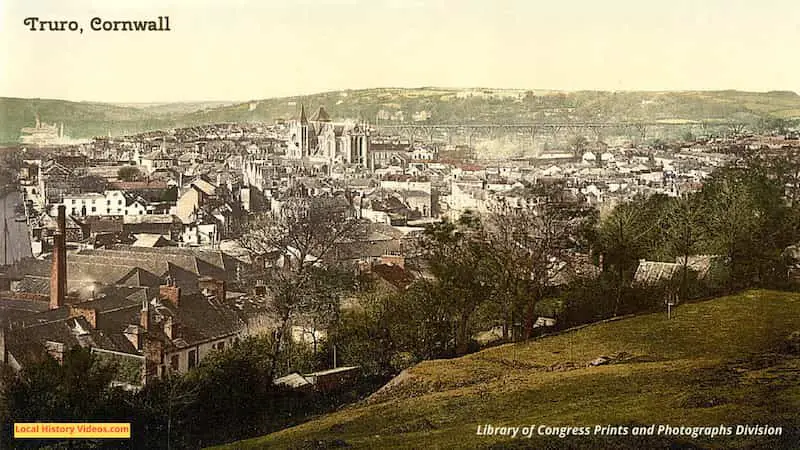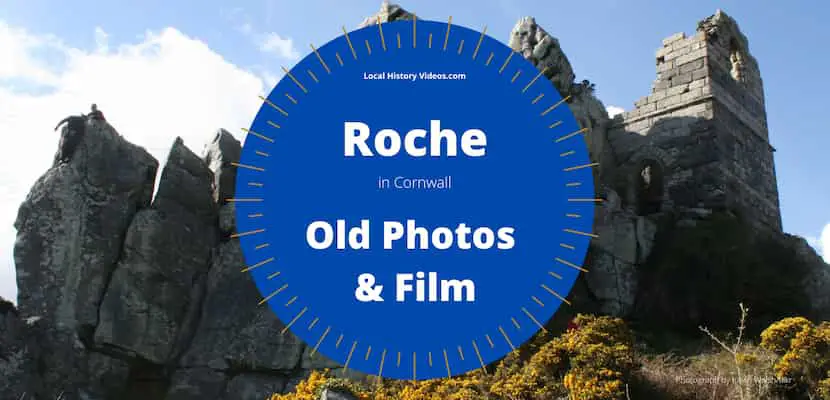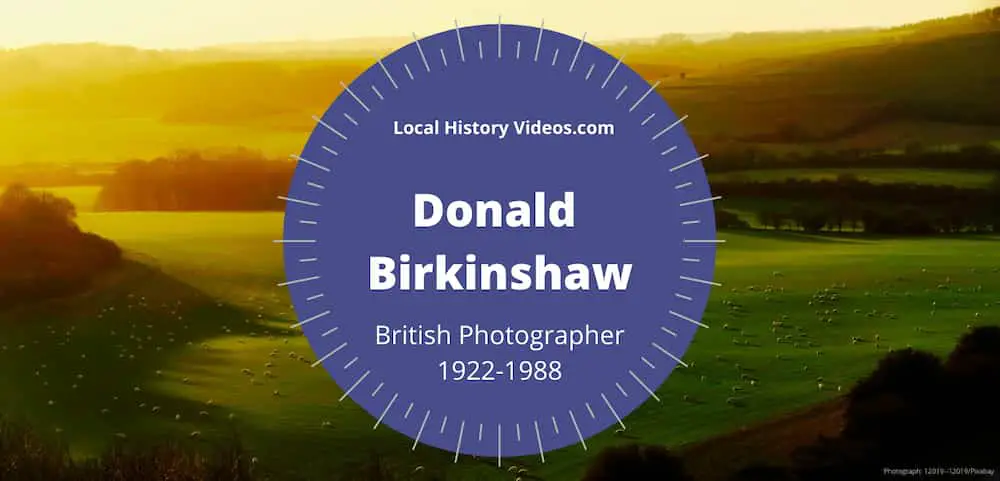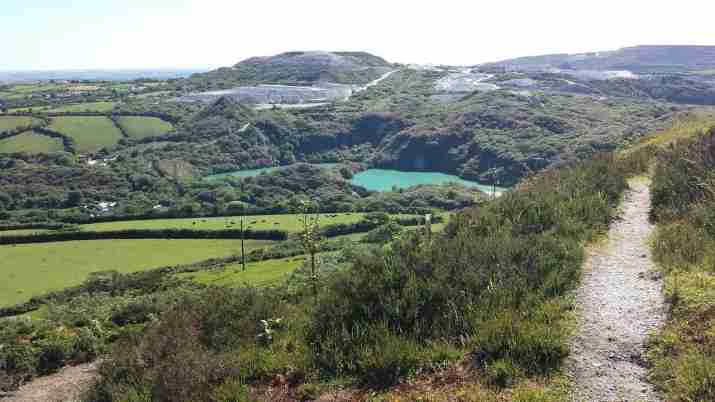Glimpse history through old images of St Austell, Cornwall.
St Austell is one of the largest towns in Cornwall, with a population nudging 20,000 people. It boasts a lovely beach well known to locals, tourists, and film crews.
St Austell Brewery opened in the town back in 1851, making it one of the oldest businesses in Cornwall. It’s still an independent and family-owned company, quite a rarity for such an old firm.
Nearby are the china clay pits, which have been captured on film several times from the post-war era onwards.
Thanks to dena187 for use of the image shown at the top of this page.
Old Pictures Of St Austell
New and Old Pictures
A collection of new and old pictures of St Austell in the English county of Cornwall.
This video includes just some of the many hundreds of old pictures shared on the Facebook group “St Austell area in the old days”.
St Austell Cornall new and old pictures – selwyn62 on YouTube
The second in the series, this video includes just some of the many hundreds of old pictures shared on the Facebook group “St Austell area in the old days”.
selwyn62 on YouTube
The third in the series, this video includes just some of the many hundreds of old pictures shared on the Facebook group “St Austell area in the old days”.
selwyn62 on YouTube
AGRICULTURAL SHOW IN ST AUSTELL (1930s)
There isn’t a date or any commentary. However, Prince Edward, who briefly became Edward VIII before his abdication to marry Wallace Simpson, is clearly seen in this footage. He was Prince of Wales from 23 June 1910 to 20 January 1936.
Prince of Wales Visits Agricutural Show – British Movietone on YouTube
The short film opens with scenes of the Prince inspecting the regiment.
Then there are various shots of the Prince walking around with his official party. Around them people wander about.
Note the field of cars in the background, which all look very similar.
Then we see shots of the cattle being led round the arena, many of them by women.
The Great War Hero
For a long while the camera rests on a close shot of an older, portly gentleman, who sports a big mustache. On his chest hang 4 medals, from WWI service.
Given the age of the man, and the age of the film, he was probably in active service in his mid to late 30s.
The World War I Medals
Let’s consider the medals the war veteran is wearing at the St Austell agricultural show in the 1930s.
The medal to the far left appears to be the 1914 Star, colloquially known as the Mons Star. It is a British World War I campaign medal for service in France or Belgium between 5 August and 22 November 1914. The former date is the day after Britain’s declaration of war against the Central Powers, and the closing date marks the end of the First Battle of Ypres. In total, 365,622 1914 Star medals were awarded.
Second left is the British War Medal.
“The British War Medal was a campaign medal of the British Empire, for service in World War One. It commemorates some of the most terrible battles the world has ever known. The casualties in the Ypres Salient and on the Somme for 1915 to 1918 were more than our total for the Second World War”
Forces War Records
Next along the man’s row of medals was The Victory Medal, also called the Inter Allied Victory Medal. It was never awarded alone without other service medals.
Because it was typically awarded with the 1914 Star and the British War Medal, the three medals together were known as Pip, Squeak and Wilfred.
The medal on the right is hidden from view most of the time. Without colour and a clearer view, it’s uncertain which medal it is.
Other People
Around the war veteran other people move about, some of them stopping to look at the camera.
Finally the Prince and his party walk off the field and through the quiet crowd.
St Austell In Post-War Britain
China Clay Works At Little Treviscoe Pit (1948)
This British Pathé footage captures china clay works at the Little Treviscoe Pit, which was in operation by the early 1800s.
China Clay – British Pathe on YouTube
Heaps of china clay are piled about the landscape.
High pressure water hoses wash the clay down from the pit walls. The liquid clay runs down the cliff, mixing with sand as it goes into a basin.
Then it’s pumped into the micas, a system of long channels. A man pushes the clay along with a wooden pole.
Next we see two workmen covered in clay. They shovel thick clay from a pit into a wagon, then pull the cart along a track.
Inside a drying shed the clay is tipped out into kilns. It bubbles as it dries.
Finally, we see brief and dark shots of ships docked at Fowey. They’re being loaded with dried clay.
St Austell In The 1960s
China Clay (1964)
Following its 1948 visit, British Pathé returned to look at the china clay pits.
It’s like a lunar landscape, but with a truck passing by.
China Clay (1964) – British Pathe on YouTube
A man supervises a hose as it blasts the clay pits with a fierce jet of water. The clay explodes away from the rock face and cascades down into the valley.
The liquid clay runs in rivers to huge vats that rotate to extract the clay.
The resulting powder falls through a chute into a huge storage tank.
A man stands at the base of one of the clay ‘mountains’ and picks up a handful.
The powder is seen being tipped from a lorry onto a conveyor belt, taking the clay to the hold of a ship.
Redevelopment in the 1960s
In the 1960s, St Austell saw the demolition of slum dwellings, and the construction of Trinity Street and Aylmer Square. Three videos show this modern progress in action through old photos.
St Austell Redevelopment 1960’s Part 1 – Jrybialek on YouTube
St Austell 1960’s Redevelopment Part 2 – Jrybialek on YouTube
St Austell Redevelopment 1960’s Part 3 – Jrybialek on YouTube
St Austell In The 1970s
St Austell (1970s)
This 1970s home movie features a bit of St Austell, with a drive out towards Lostwithiel.
St Austell 1970’s old cine film 112 – YouTube
St. Austell Punk Movie (1970s)
This is a trailer for the DVD DEMOLITION SQUAD – How Punk actually began in a shed in Cornwall, which can be purchased at buttztv.co.uk.
DEMOLITON SQUAD St Austell punk movie – Buttz TV on YouTube
St Austell In The 1980s
China Clay Train (1980s)
This 1980s short film is in the Huntley Film Archives.
A goods train travels along the Fowey line, transporting china clay to Carne Point in Cornwall.
It is filmed from a distance as it crosses the green countryside. St Winnow church and the graveyard appear, with a view across the bay beyond.
We then see a 3 way sign post pointing to St Winnow, Lostwithiel & Lerryn. Another arrow warns “impracticable for cars”.
Then there’s a warning sign for road flooding at high tide.
The train proceeds along the estuary, where small boats rest in the sand with the tide out.
Finally, we see the car ferry crossing the River Fowey.
China Clay Train Cornwall, 1980s – Film 61560 – Huntley film Archives on YouTube
St Austell In The 1990s
Student Film (1991)
In the Christmas break of 1991, four university students, including James Hawke, made a home video in and around St Austell.
St Austell, Please! (1991) by James Hawke – Aylmer Square on YouTube
Queens Head Pub (1991)
A short home video shot on 29th December 1991 in the Queen’s Head pub.
Queens Head Pub St Austell – 28.12.1991: wastedon4loko on YouTube
St Austell Buses (2000)
A trailer of a DVD you can buy, showing the local buses in action in 2000. Also features passers-by and glimpses of local roads.
ST AUSTELL BUSES 2000 – DaveSpencer32 on YouTube
A Drive Through St Austell (2007)
From charlestown roundabout (with the flags of ozzel) through the town centre.
St Austell (Sen Ostell), Cornwall – A Cars view. – Gavin Holcroft on YouTube
Carlyon Bay (2007)
The Dracula film released in 1979 included a shipwreck scene with a beach. The filming happened at Carlyon Bay at St Austell.
The film’s shipwreck was left on the beach for several years, before a big storm in the 1980s swept it away.
In 1986 the beach at Carlyon Bay once again saw a location shoot, this time for the pop video accompanying Alison Moyet’s “Is this love?”. This single was released in the UK in November 1986, and in North America in March 1987.
In 2007, a beachside resort was planned for Carlyon Bay so this home recording of the beach was made before it happened.
Dracula (1979) St Austell beach location re-visited: chez1807 on YouTube
St Austell Bus Station (2009)
A short recording of some buses operating in St Austell in July 2009.
St Austell bus station July 2009 – Video47 on YouTube
Newquay to St Austell (2009)
Newquay to St Austell Inter Urban Link – GKMB1948 on YouTube
Eden Project Biomes, St Austell, Cornwall (2009)
Eden Project Biomes, St Austell, Cornwall – SpeedyHeadcleaner on YouTube
St Austell 2010-2019
St Austell Brewery Visitor Centre (2010)
St Austell Brewery Visitor Centre – staustellbrewerytv on YouTube
The Eden Project Cafe (2011)
The Eden Project Cafe opened in 2011 in St Austell’s White River Place development.
This is a short film by Zara Maung about the Eden Project’s environmentally sustainable cafe.
Find out about the sustainability features as well as the book exchange and veg exchange.
The Eden Project Cafe in St Austell town centre, Cornwall – edenprojecttv on YouTube
You may also like
- Old Images of Cornwall, England

- Old Images of Truro, Cornwall

- Old Images of Newquay, Cornwall

- Old Images of Roche, Cornwall

- Donald Birkinshaw, Photographer (1922-1988)

Fnd more locations on Local History Videos with the Sitemap for England

